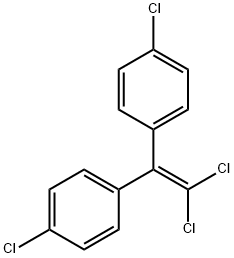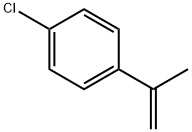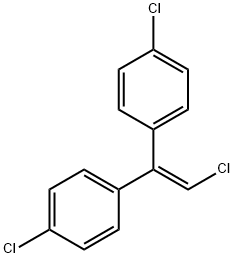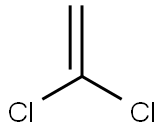4,4'-DDE
Synonym(s):p,p-DDE;1,1-Dichloro-2,2-bis(4-chlorophenyl)ethene;1,1-Dichloro-2,2-bis(4-chlorophenyl)ethene solution;4,4′-DDE;4,4′-DDE solution
- CAS NO.:72-55-9
- Empirical Formula: C14H8Cl4
- Molecular Weight: 318.03
- MDL number: MFCD00000837
- EINECS: 200-784-6
- SAFETY DATA SHEET (SDS)
- Update Date: 2024-12-18 14:15:30

What is 4,4'-DDE?
Chemical properties
white crystalline powder
The Uses of 4,4'-DDE
Military product; chemical research. Degradation product of p,p′-DDT.
The Uses of 4,4'-DDE
1,1-Dichloro-2,2-bis(4-chlorophenyl)ethane(DDE) has been used to study the ability of Pseudomonas acidovorans M3GY to transform DDE and its unchlorinated analog, 1,1-diphenylethylene (DPE).It has been used to investigate the role of incubation time, solvent type, yeast inoculum growth stage and concentration on the results of yeast assay for estrogenic compounds.
What are the applications of Application
1,1-Dichloro-2,2-bis(4-chlorophenyl)ethene is a potent androgen receptor antagonist
Definition
ChEBI: A chlorophenylethylene that is ethylene substituted by two 4-chlorophenyl groups at position 1 and two chlorine atoms at position 2.
General Description
White crystalline solid or white powder.
Air & Water Reactions
Insoluble in water.
Reactivity Profile
4,4'-DDE is sensitive to exposure to light. 4,4'-DDE is incompatible with strong oxidizing agents and strong bases. Oxidation is catalyzed by UV radiation.
Health Hazard
A derivative of DDT; structurally and toxicproperties are similar to those of DDT;however, the acute effects are somewhatmilder; moderately toxic by ingestion; ateratogenic substance; adequate evidence ofcarcinogenicity in experimental animals
LD50 oral (rat): 880 mg/kg
LD50 oral (mouse): 700 mg/kg.
Fire Hazard
Flash point data for 4,4'-DDE are not available. 4,4'-DDE is probably combustible.
Safety Profile
Suspected carcinogen withexperimental carcinogenic and neoplastigenic data. Poisonby ingestion. Experimental reproductive effects. Mutationdata reported. An insecticide. When heated todecomposition it emits very toxic fumes of Cl-.
Source
Agricultural runoff degradation of p,p′-DDT (quoted, Verschueren, 1983).
Environmental Fate
Biological. In four successive 7-day incubation periods, p,p′-DDE (5 and 10 mg/L) was recalcitrant to degradation in a settled domestic wastewater inoculum (Tabak et al.,1981).
Photolytic. When an aqueous solution of p,p′-DDE (0.004uM) in natural water samples
collected from California and Hawaii was irradiated (maximum λ= 240 nm) for 120
hours, 62% was photooxidized to p,p′-dichlorobenzophenone (Ross and Crosby, 1985).
When p,p′-DDE in water was irradiated at 313 nm, a quantum yield of 0.3 was
achieved. A photolysis half-life of 0.9 days in summer and 6.1 days in winter by direct
sunlight at 40° latitude was observed. Photolysis products included DDMU (yield 20%),
o-chl
When p,p′-DDE in a methanol solvent was photolyzed at 260 nm, a dichloro-benzophenone,
a dichlorobiphenyl, DDMU and 3,6-dichlorofluorenone (yield 10%) formed
as the major products (Plimmer et al., 1970).
Chemical/Physical. May degrade to bis(chlorophenyl)acetic acid (DDA) and hydrochloric
acid in water (Verschueren, 1983) or oxidize to p,p′-dichlorobenzophenone using
UV light as a catalyst (U.S. Department of Health and Human Services, 1989).
Purification Methods
Crystallise DDE from MeOH or EtOH and dry it in vacuo. The purity is checked by TLC. [G.tzi & Stammbach Helv Chim Acta 28 569 1946, Beilstein 5 H 639, 5 III1891.] POSSIBLE CARCINOGEN.
Properties of 4,4'-DDE
| Melting point: | 88-90 °C(lit.) |
| Boiling point: | 403.45°C (rough estimate) |
| Density | 1.3406 (rough estimate) |
| vapor pressure | 13 at 30 °C (Wescott et al., 1981) |
| refractive index | 1.6000 (estimate) |
| Flash point: | 11 °C |
| storage temp. | 2-8°C |
| solubility | ethanol: soluble |
| form | neat |
| form | Solid |
| color | White, crystalline, odorless powder |
| Water Solubility | 292mg/L(25 ºC) |
| BRN | 1913355 |
| Henry's Law Constant | 0.33 at 25 °C (gas stripping-GC, Jantunen and Bidleman, 2006) |
| Stability: | Stable, but light-sensitive. Incompatible with strong bases, strong oxidizing agents. |
| EPA Substance Registry System | p,p'-DDE (72-55-9) |
Safety information for 4,4'-DDE
| Signal word | Danger |
| Pictogram(s) |
 Skull and Crossbones Acute Toxicity GHS06  Health Hazard GHS08  Environment GHS09 |
| GHS Hazard Statements |
H301:Acute toxicity,oral H351:Carcinogenicity H372:Specific target organ toxicity, repeated exposure H410:Hazardous to the aquatic environment, long-term hazard |
| Precautionary Statement Codes |
P201:Obtain special instructions before use. P273:Avoid release to the environment. |
Computed Descriptors for 4,4'-DDE
New Products
(S)-3-Aminobutanenitrile hydrochloride 4-Methylphenylacetic acid N-Boc-D-alaninol N-BOC-D/L-ALANINOL Tert-butyl bis(2-chloroethyl)carbamate 3-Morpholino-1-(4-nitrophenyl)-5,6-dihydropyridin- 2(1H)-one Furan-2,5-Dicarboxylic Acid Tropic acid 1-Bromo-3,5-Di-Tert-Butylbenzene S-2-CHLORO PROPIONIC ACID ETHYL ISOCYANOACETATE 2-Bromo-1,3-Bis(Dimethylamino)Trimethinium Hexafluorophosphate 4-IODO BENZOIC ACID 3-NITRO-2-METHYL ANILINE 1-(2,4-DICHLOROPHENYL) ETHANAMINE (2-Hydroxyphenyl)acetonitrile 4-Bromopyrazole 2-(Cyanocyclohexyl)acetic acid 4-methoxy-3,5-dinitropyridine 1-(4-(aminomethyl)benzyl)urea hydrochloride 2-aminopropyl benzoate hydrochloride diethyl 2-(2-((tertbutoxycarbonyl)amino) ethyl)malonate tert-butyl 4- (ureidomethyl)benzylcarbamate Ethyl-2-chloro((4-methoxyphenyl)hydrazono)acetateRelated products of tetrahydrofuran








You may like
-
 2,2-Bis(4-chlorophenyl)-1,1-dichloroethylene CAS 72-55-9View Details
2,2-Bis(4-chlorophenyl)-1,1-dichloroethylene CAS 72-55-9View Details
72-55-9 -
 4,4′-DDE CAS 72-55-9View Details
4,4′-DDE CAS 72-55-9View Details
72-55-9 -
 4,4′-DDE CAS 72-55-9View Details
4,4′-DDE CAS 72-55-9View Details
72-55-9 -
 1975-50-4 98%View Details
1975-50-4 98%View Details
1975-50-4 -
 2-HYDROXY BENZYL ALCOHOL 98%View Details
2-HYDROXY BENZYL ALCOHOL 98%View Details
90-01-7 -
 2-Chloro-1,3-Bis(Dimethylamino)Trimethinium Hexafluorophosphate 221615-75-4 98%View Details
2-Chloro-1,3-Bis(Dimethylamino)Trimethinium Hexafluorophosphate 221615-75-4 98%View Details
221615-75-4 -
 14714-50-2 (2-Hydroxyphenyl)acetonitrile 98+View Details
14714-50-2 (2-Hydroxyphenyl)acetonitrile 98+View Details
14714-50-2 -
 118753-70-1 98+View Details
118753-70-1 98+View Details
118753-70-1